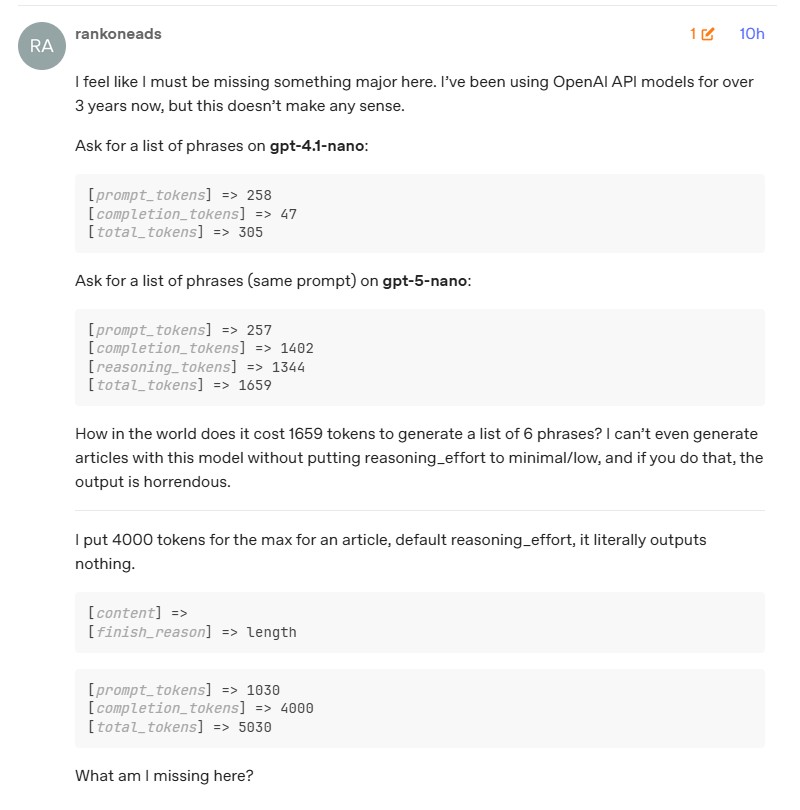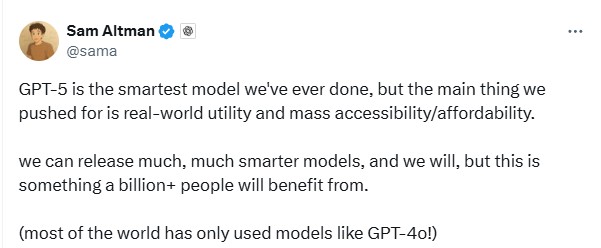GPT-5 Release Sparks User Disappointment: Limited Upgrades, Ongoing Controversy
After the official release of OpenAI’s latest large model GPT-5, despite the official claims of significant improvements in reasoning, coding, and more, a large number of users reported that its performance fell short of expectations. Short responses, lack of personality, functional limitations, and the direct removal of older models have triggered widespread dissatisfaction and discussion.

OpenAI officially launched its highly anticipated new large model GPT-5 in August, claiming comprehensive leadership in reasoning, writing, coding, health, and other fields. However, the actual user experience and feedback from online communities have been notably disappointing, with discussions about “limited upgrades” and “degraded experience” quickly sweeping through the global tech community.
Limited Upgrades, Underwhelming User Experience
As a highly awaited AI large model iteration in the industry, OpenAI CEO Sam Altman repeatedly described GPT-5 before release as a “pocket-sized team of PhDs,” claiming it to be the company's most powerful AI expert model to date. According to official information, GPT-5 breaks historical records on multiple mainstream AI benchmarks including reasoning, code quality, and multimodal understanding, supports larger text windows, and introduces new features such as tool use and personalized configurations.

However, based on real user feedback, many did not sense the anticipated “revolutionary progress.” Since OpenAI simultaneously disabled user switching permissions for older models like GPT-4o and 4.1, all users are forced to use GPT-5/GPT-5-Thinking by default or mandate, a move criticized as a “forced downgrade.” The GPT5 is horrible thread has received 4.3K likes and 1.6K comments within a day, garnering widespread discussion. Similar threads like OpenAI just pulled the biggest bait-and-switch in AI history and I'm done. also reflect users’ dissatisfaction with this forced change done without prior notice or consent—resulting in the disappearance of the AI companion they had grown accustomed to. This also somewhat reflects OpenAI’s arrogance toward its loyal users.
Many social media and tech community users point out that GPT-5’s answers are shorter, more mechanical in form, and its ability to respond to complex instructions has actually declined. Meanwhile, the new model’s “personality” is lacking, expressions are more rigid, “chat enjoyment has decreased,” and some paying users report a significant daily usage limit reduction and triggering of reply restrictions.
A Reddit user commented: “This isn’t an upgrade, it’s a step back. GPT-5 hallucinates, forgets context, and is unstable, while GPT-4o is actually more focused and reliable.” Others complain: “Short replies, frequent errors, ignoring commands—it’s worse than before, and they won’t let us switch back to the original models.”
Limited Technical Progress and Industry Bottlenecks
According to multiple industry evaluations and independent blogger experiences, GPT-5 does achieve relatively high standards in some structured areas (like complex reasoning, health consultations, specialized code evaluations), but the rate of progress compared to the previous generation has slowed significantly, and it remains far from true “general artificial intelligence.”
Competitors like Anthropic and Google have invested heavily in recent years, resulting in “intense competition” across the industry in areas such as reasoning, code generation, and tool invocation, causing flagship models to converge in performance. As industry commentary states: “GPT-5 mainly brings quality improvements and user experience refinements, far from a ‘giant leap.’” Mashable commented: “GPT-5’s upgrades focus mainly on math and programming, but overall progress can’t compare to past major leaps.”
New Issues and Concerns: Safety, Compliance, and Hallucinations
Despite OpenAI’s claim that GPT-5 further reduces hallucinations, improves safety compliance, and diversifies response content, the new model still shows certain factual errors, content misjudgments, and opaque refusal mechanisms that generate controversy. Media like PCMag revealed that while GPT-5 improves on “brown-nosing” tendencies and fabricated facts, its tolerance for low-intensity “hate speech” and similar inappropriate requests has increased somewhat, causing fluctuations in its safety compliance scores.

Moreover, after opening the new model’s API, although caching fees have decreased, additional inference costs have confused some small and medium developers. The API has become less reliable, with some simple replies consuming thousands of inference tokens. Some AI entrepreneurs point out: “GPT-5’s inference costs are high; as model complexity increases, so do computing resource demands and environmental pressures.”
Official Response

In response to complaints and doubts, OpenAI and its team replied via official forums and social media, emphasizing GPT-5’s “real-world usability” and “accessibility,” stating it will “continue refining the model experience” with ongoing iterations and optimizations. Meanwhile, overseas tech media comment sections and professional communities have seen increasing discussions about whether OpenAI faces an AI industry “innovation bottleneck” and whether competitors are starting to catch up.
Conclusion: High Industry Expectations vs. Reality Gap
The release of GPT-5 shows that large model evolution has entered a new stage of industrialization and refined competition. Leveraging a strong brand and massive user base, every iteration of GPT-5 moves the entire industry and public nerve center. However, this cycle has revealed the phase characteristics of AI development’s “gradual - pain - breakthrough” due to technological bottlenecks, data resource consumption, and cost pressures.
For ordinary users, GPT-5 probably will not bring a qualitative AI change or more “surprise” in the short term, appearing more like a routine “optimization + integration + market expansion” upgrade. For the AI industry, this serves as a collective reminder to think deeply—only with solid groundwork, balancing innovation and user experience, can the next truly meaningful intelligent revolution be possible.
References
- OpenAI faces backlash as GPT-5 reaches all users
- Platformer: GPT-5 is alive
- Mashable: GPT-5 arrives imminently. Here's what the hype won't tell you.
- Mashable: OpenAI's GPT-5: Why it's not that much better than GPT-4
- Futurism: GPT-5 Users Say It Seriously Sucks
- Mathrubhumi: Social media roasts GPT-5
- Daily.dev: GPT-5 by OpenAI: everything you should (and shouldn't) ...
- PCMag: GPT-5 Is Less of a Suck-Up, But It Tolerates More ...
- Lifehacker: Everything We Know About GPT-5, OpenAI's Latest Model
- Qodo.AI: Benchmarking GPT-5 on Real-World Code Reviews
- AI-Supremacy: OpenAI GPT-5 One unified system
- The Algorithmic Bridge: GPT-5: OpenAI’s Flagship Model Faces Great Expectations
- Futurism: GPT-5 Users Say It Seriously Sucks
- Mathrubhumi: Social media roasts GPT-5



